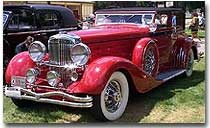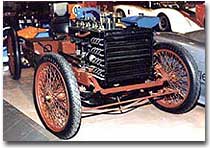46a. The Age of the Automobile

Cruising in automobiles such as the Duesenberg pictured above was popular in America, but this typically Sunday afternoon family past time was largely discontinued during the depression.
Perhaps no invention affected American everyday life in the 20th century more than the automobile.
Although the technology for the automobile existed in the 19th century, it took Henry Ford to make the useful gadget accessible to the American public. Ford used the idea of the assembly line for automobile manufacturing. He paid his workers an unprecedented $5 a day when most laborers were bringing home two, hoping that it would increase their productivity. Furthermore, they might use their higher earnings to purchase a new car.
Ford reduced options, even stating that the public could choose whatever color car they wanted — so long as it was black. The Model T sold for $490 in 1914, about one quarter the cost of the previous decade. By 1920, there were over 8 million registrations. The 1920s saw tremendous growth in automobile ownership, with the number of registered drivers almost tripling to 23 million by the end of the decade.
Economic Spin-offs
The growth of the automobile industry caused an economic revolution across the United States. Dozens of spin-off industries blossomed. Of course the demand for vulcanized rubber skyrocketed. Road construction created thousands of new jobs, as state and local governments began funding highway design.

Even the federal government became involved with the Federal Highway Act of 1921. Gas stations began to dot the land, and mechanics began to earn a living fixing the inevitable problems. Oil and steel were two well-established industries that received a serious boost by the demand for automobiles. Travelers on the road needed shelter on long trips, so motels began to line the major long-distance routes.
Even cuisine was transformed by the automobile. The quintessential American foods — hamburgers, french fries, milk shakes, and apple pies — were hallmarks of the new roadside diner. Drivers wanted cheap, relatively fast food so they could be on their way in a hurry. Unfortunately, as new businesses flourished, old ones decayed. When America opted for the automobile, the nation's rails began to be neglected. As European nations were strengthening mass transit systems, individualistic Americans invested in the automobile infrastructure.
Effects of the Automobile
The social effects of the automobile were as great. Freedom of choice encouraged many family vacations to places previously impossible. Urban dwellers had the opportunity to rediscover pristine landscapes, just as rural dwellers were able to shop in towns and cities. Teenagers gained more and more independence with driving freedom. Dating couples found a portable place to be alone as the automobile helped to facilitate relaxed sexual attitudes.
Americans experienced traffic jams for the first time, as well as traffic accidents and fatalities. Soon demands were made for licensure and safety regulation on the state level. Despite the drawbacks, Americans loved their cars. As more and more were purchased, drivers saw their worlds grow much larger.






